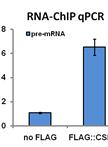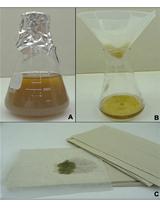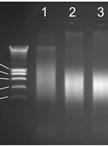- Submit a Protocol
- Receive Our Alerts
- Log in
- /
- Sign up
- My Bio Page
- Edit My Profile
- Change Password
- Log Out
- EN
- EN - English
- CN - 中文
- Protocols
- Articles and Issues
- For Authors
- About
- Become a Reviewer
- EN - English
- CN - 中文
- Home
- Protocols
- Articles and Issues
- For Authors
- About
- Become a Reviewer
Chromatin Immunoprecipitation (ChIP), Streptavidin and ATP-agarose Mediated Pull-down Analyses
Published: Vol 3, Iss 18, Sep 20, 2013 DOI: 10.21769/BioProtoc.901 Views: 15107
Reviewed by: Anonymous reviewer(s)

Protocol Collections
Comprehensive collections of detailed, peer-reviewed protocols focusing on specific topics
Related protocols

RNA Chromatin Immunoprecipitation (RNA-ChIP) in Caenorhabditis elegans
Germano Cecere and Alla Grishok
Dec 20, 2014 15109 Views

Chromatin Immunoprecipitation (ChIP) Assay for Detecting Direct and Indirect Protein – DNA Interactions in Magnaporthe oryzae
Gang Li [...] Richard A. Wilson
Nov 5, 2015 15370 Views
Abstract
Epstein-Barr virus (EBV) nuclear antigen 2 (EBNA2) induces expression of both viral and cellular genes in virus infected B cells by mimicking activated Notch receptors (Notch-IC) that mediate transcription activation through binding to the repressing domain of the recombining binding protein suppressor of hairless (RBP-Jκ). In general, chromatin immunoprecipitation (ChIP) assays, electrophoresis mobility shift assays (EMSA), streptavidin-agarose mediated DNA pull-down assays, together with cell-based transcription reporter assays were conducted to verify whether the query protein is involved in EBNA2-dependent transcription. The ATP-bound state of nuclear chaperone nucleophosmin (NPM1) has been implicated in pleiotropic biological processes. An ATP-agarose-mediated pull-down protocol was developed to monitor the formation of the pre-initiation complex that is induced by ATP-bound NPM1. According to EBNA2 and Notch-IC have been shown to be partially interchangeable with respect to activation of target genes in B cell lines, it is conceivable that EBNA2 is a biological equivalent of an activated Notch IC.
Background
Part I: ATP Depletion
Materials and Reagents
- Glucose (-) RPMI 1640 (Life Technologies, catalog number: 11879020 )
- 10% Fetal Calf Serum (Life Technologies, Gibco®)
- Penicillin/streptomycin (Life Technologies, catalog number: 15140-122 )
- Glutamine (Life Technologies, catalog number: 25030-081 )
- Deoxyglucose (Sigma-Aldrich, catalog number: D6134 )
- Antimycin A (Sigma-Aldrich, catalog number: A8674 )
- RPMI 1640 (Life Technologies, catalog number: 31800089 )
- ATP depletion medium (see Recipes)
- Culture medium for IB4 LCL (see Recipes)
Equipment
- CO2 incubator (Thermo Fisher Scientific Forma CO2 incubator)
- Centrifuge (Eppendorf, model: 5810R )
Procedure
- Pellet 5 x 106 of lymphoblastoid cells and replenish with 5 ml of ATP-depletion medium.
- Incubate cells at CO2 incubator (37 °C) for two hours.
- Collect cells by spin at 1,050 rpm (220 x g; Eppendorf 5810R) for 5 min.
- Wash cells twice with 1x PBS and save for further experimental purpose.
Recipes
- ATP depletion medium
Glucose (-) RPMI 1640 was supplemented with:
10% Fetal Calf Serum
100 U/ml Penicillin/100 μg/ml streptomycin
2 mM Glutamine
2 mM deoxyglucose
300 nM antimycin A - Culture medium for IB4 LCL
RPMI 1640 was supplemented with:
10% Fetal Calf Serum
100 U/ml Penicillin/100 μg/ml streptomycin
2 mM Glutamine
References
- Liu, C. D., Chen, Y. L., Min, Y. L., Zhao, B., Cheng, C. P., Kang, M. S., Chiu, S. J., Kieff, E. and Peng, C. W. (2012). The nuclear chaperone nucleophosmin escorts an Epstein-Barr Virus nuclear antigen to establish transcriptional cascades for latent infection in human B cells. PLoS Pathog 8(12): e1003084.
Part II: Streptavidin-agarose Mediated DNA Pull-down Assay
Materials and Reagents
- DNA template (In this case: LMP1 promoter reporter plasmid)
Note: Transcription of LMP1 promoter is essential for EBV latent infection. - Biotin-labeled primers (Vita Genomics)
- IB4 lymphoblastoid cells (LCL)
- DNA elution column (Geneaid Biotech)
- Streptavidin-conjugated agarose (Life Technologies, catalog number: SA100-04 )
- 2x SDS sample buffer
- NP-40 (Sigma-Aldrich, catalog number: I8896 )
- Pepstatin A (Sigma-Aldrich, catalog number: P5318 )
- Aprotinin (Sigma-Aldrich, catalog number: A1153 )
- Leupeptin (Sigma-Aldrich, catalog number: L2884 )
- Phenylmethanesulfonyl fluoride (Sigma-Aldrich, catalog number: P7626 )
- Lysis buffer (see Recipes)
- Protease inhibitors (see Recipes)
Equipment
- PCR product elution column (Geneaid Biotech)
- Centrifuge (Eppendorf, model: 5810R )
- Centrifuge (Eppendorf, model: 5415R )
- Rocker (Tube rotator)
- PCR machine (MJ Research, model: PTC 200 Thermal Cycler )
- Gel electrophoresis equipment (Embi Tec, model: RunOneTM Electrophoresis System )
- Western blot equipment (Bio-Rad, model: Mini-protean 3 )
Procedure
- Amplify the biotin or non-biotin labeled DNA fragments of the query promoter in a 100 μl reaction volume by PCR.
- Elute PCR product by passing through an elution column with 100 μl elution buffer and take 5 μl DNA (5% input DNA) for performing gel electrophoresis.
- Take 1 x 107 lymphoblastoid cells to be lysed with 1 ml of lysis buffer, put the reaction tubes on a rocker and incubate at 4 °C for 1 h. Collect supernatant by spining at 13,200 rpm (16,100 x g; Eppendorf 5415R), 4 °C.
- Add desired biotin-labelled or non-biotin-labelled DNA to supernatant and put tubes onto the rocker and incubate at 4 °C for another hour.
- Add 40 μl streptavidin-conjugated agarose to each tube and put the tubes onto the rocker again, and wait for 30 min to allow the affinity binding of streptavidin with biotin to complete.
- Harvest biotin-labelled DNA by spining at 1,050 rpm (220 x g; Eppendorf 5810R), 4 °C for 5 min.
- Wash the collected streptavidin-conjugated agarose beads with 500 μl lysis buffer five times and add 40 μl 2x SDS sample buffer to each sample and use them for western blot analysis.
Recipes
- Lysis buffer (for 1 L)
1% NP-40
2 mM EDTA
10% Glycerol
50 mM Tris-HCl
150 mM NaCl - Protease inhibitors
1 μg/ml Pepstatin A
1 μg/ml Aprotinin
1 μg/ml Leupeptin
0.5 mM Phenylmethanesulfonyl fluoride
*Lysis buffer is supplemented with the indicated protease inhibitors
References
- Liu, C. D., Chen, Y. L., Min, Y. L., Zhao, B., Cheng, C. P., Kang, M. S., Chiu, S. J., Kieff, E. and Peng, C. W. (2012). The nuclear chaperone nucleophosmin escorts an Epstein-Barr Virus nuclear antigen to establish transcriptional cascades for latent infection in human B cells. PLoS Pathog 8(12): e1003084.
Part III: ATP-agarose Mediated Pull-down Analyses
Materials and Reagents
- IB4 LCL cells
- Adenosine 5′-triphosphate-Agarose (Sigma-Aldrich, catalog number: A2767-1 ml )
- 2x SDS sample buffer
- Glucose (-) RPMI 1640 (Life Technologies, catalog number: 11879020 )
- Fetal Calf Serum (Life Technologies, Gibco®)
- Penicillin/streptomycin (Life Technologies, catalog number: 15140-122 )
- Deoxyglucose (Sigma-Aldrich, catalog number: D6134 )
- Antimycin A (Sigma-Aldrich, catalog number: A8674 )
- RPMI 1640 (Life Technologies, catalog number: 31800089 )
- Glutamine (Life Technologies, catalog number: 25030-081 )
- Pepstatin A (Sigma-Aldrich, catalog number: P5318 )
- Aprotinin (Sigma-Aldrich, catalog number: A1153 )
- Leupeptin (Sigma-Aldrich, catalog number: L2884 )
- Phenylmethanesulfonyl fluoride (PMSF) (Sigma-Aldrich, catalog number: P7626 )
- ATP-depletion culture medium (see Recipes)
- Lysis buffer (see Recipes)
- Protease inhibitor cocktail (see Recipes)
- Culture medium for IB4 LCL (see Recipes)
Equipment
- CO2 incubator
- Centrifuge (Eppendorf, model: 5415D )
- Centrifuge (Eppendorf, model: 5810R )
- Centrifuge (Eppendorf, model: 5415R )
- Rocker
- Western blot equipment (Bio-Rad Laboratories)
Procedure
- Collect 1 x 107 of IB4 LCL cells by spin at 1,050 rpm (220 x g; Eppendorf 5810R) and replenish with 5 ml of ATP-depletion culture medium and incubate at CO2 incubator (37 °C) for 2 h.
- Harvest cells and wash them twice with 1x PBS.
- Lyse cells in 0.5 ml of lysis buffer and put the reaction tubes on a rocker and incubate at 4 °C for 1 h. Collect supernatant (cellular proteins) by spining at 13,200 rpm (16,100 x g; Eppendorf 5415R), 4 °C for 10 min.
- Add 50 μl ATP-agarose to pull down cellular protein by sitting on a rocker and incubate at 4 °C for 4 hours.
- Collect ATP-agarose beads by spining at 5,000 rpm (2,300 x g; Eppendorf 5415R) for 1 min and wash beads with lysis buffer five times.
- Add 40 μl 2x SDS sample buffer to each collected pull-down sample.
- Identify the ATP-bound proteins by western blot analysis.
Recipes
- Lysis buffer (for 1 L)
1% NP-40
2 mM EDTA
10% Glycerol
50 mM Tris-HCl
150 mM NaCl - Protease inhibitors
1 μg/ml Pepstatin A
1 μg/ml Aprotinin
1 μg/ml Leupeptin
0.5 mM Phenylmethanesulfonyl fluoride
*Lysis buffer is supplemented with the indicated protease inhibitors - ATP-depletion culture medium
Glucose (-) RPMI 1640 was supplemented with:
10% Fetal Calf Serum
100 U/ml Penicillin/100 μg/ml streptomycin
2 mM Glutamine
2 mM deoxyglucose
300 nM antimycin A - Culture medium for IB4 LCL
RPMI 1640 was supplemented with:
10% Fetal Calf Serum
100 U/ml Penicillin/100 μg/ml streptomycin
2 mM Glutamine
References
- Liu, C. D., Chen, Y. L., Min, Y. L., Zhao, B., Cheng, C. P., Kang, M. S., Chiu, S. J., Kieff, E. and Peng, C. W. (2012). The nuclear chaperone nucleophosmin escorts an Epstein-Barr Virus nuclear antigen to establish transcriptional cascades for latent infection in human B cells. PLoS Pathog 8(12): e1003084.
Part IV: Chromatin Immunoprecipitation (ChIP) Assay
Materials and Reagents
- ATP-depleted Lymphoblastoid cells
- IB4 LCL cells (Lymphoblastoid cell lines)
- 36.5% Formadehyde (Sigma-Aldrich, catalog number: F8775 )
- Glycerol (Sigma-Aldrich, catalog number: F8775 )
- EDTA (Sigma-Aldrich, catalog number: EDS )
- Chromatin Shearing Kit (Active Motif)
- DNA nuclease (Active Motif)
- Enzyme digestion buffer (Active Motif)
- Protein A/G agarose (EMD Millipore, catalog number: IP10-10ML )
- Primary antibodies (Ab1, Ab2 and H3-Ac)
In this case:
Ab1: EBV nuclear antigen 2 specific antibody (e.g. Abcam, catalog number: ab49498 )
Ab2: Nucleophosmin antibody (5E3) (Santa Cruz, catalog number: sc-53926 )
Ab3: H3-acetylated antibody (H3-Ac) (EMD Millipore, catalog number: 06599 ) - IgG (Dako, catalog number: A0424 )
- TE buffer
- 1 M Tris-HCl
- Proteinase K (Life Technologies, catalog number: 25530049 )
- Glucose (-) RPMI 1640 (Life Technologies, catalog number: 11879020 )
- RPMI 1640 (Life Technologies, catalog number: 31800089 )
- Fetal Calf Serum (Life Technologies, Gibco®)
- Penicillin/streptomycin (Life Technologies, catalog number: 15140-122 )
- Glutamine (Life Technologies, catalog number: 25030-081 )
- Deoxyglucose (Sigma-Aldrich, catalog number: D6134 )
- Antimycin A (Sigma-Aldrich, catalog number: A8674 )
- ChIP lysis buffer (see Recipes)
- 10x Glycine (see Recipes)
- ChIP dilution buffer (see Recipes)
- Low Salt Immune Complex Wash Buffer (see Recipes)
- High Salt Immune Complex Wash Buffer (see Recipes)
- LiCl Immune Complex Wash Buffer (see Recipes)
- Elution buffer (see Recipes)
- ATP depletion medium (see Recipes)
- Culture medium for IB4 LCL (see Recipes)
- Enzyme solution (see Recipes)
- Protease inhibitors (see Recipes)
Equipment
- DNA spin column (Geneaid Biotech)
- Douncer apparatus (Tissue grinder) (Thomas scientific)
- Centrifuge (Eppendorf, model: 5810R )
- Centrifuge (Eppendorf, model: 5415R )
- Centrifuge (Eppendorf, model: 5415D )
- Rocker (Fisher scientific, model: 05-450-200 )
- 1.7 ml cryptal vial
- Bench top mini centrifuge (Thermo Fisher Scientific)
- Illumina Eco Real Time PCR system
Procedure
- Take 2 x 106 of ATP-depleted or regular IB4 LCL cells and replenish with 10 ml of ATP-depletion or regular culture medium.
- Add 274 μl of 36.5% formaldehyde to 10 ml of cells to make the final concentration as 1% and wait 10 min to allow cross link reaction to complete at room temperature.
- Add 1 ml of 10x glycine to 10 ml of cells to quench unreacted formaldehyde and swirl gently and incubate at room temperature for 5 min.
- Pellet cells at 2,000 rpm (400 x g; Eppendorf 5415D) for 5 min then aspirate supernatant and wash cells twice with 1 ml ice-cold 1x PBS. Finally, add 1 ml ice-cold ChIP lysis buffer and sit on ice for 30 min.
- Break down cells on ice by using a douncer homogenizer with 10 strokes and transfer whole cell lysate to a 1.7 ml cryptal vial. Collect nuclei by spin at 2,300 x g for 5 min. After removal of supernatant, resuspend the isolated nuclei with 260 μl digestion buffer (prewarm at 37 °C for 5 min prior to use).
- Add 12.5 μl of enzyme solution and allow enzyme digestion at room temperature for 15 min.
- Add 20 μl ice-cold EDTA to stop the reaction and pellet the digested chromatins by spining at 13,200 rpm (16,100 x g; Eppendorf 5415R), 4 °C for 10 min. The digested chromatins will be retained in supernatant (around 300 μl: can be applied for up to 5 IP) and cell debris will be left in pellet. Please keep 50 μl of supernatant as input of chromatin DNA.
- Aliquot 50 μl of supernatant into 3 new tubes [3 IP: Ab1, Ab2/H3-Ac (positive control), and IgG], and refill each sample with 950 μl ChIP dilution buffer to make a 1 ml volume. Add 20 μl Protein A/G agarose to preclean the non-specifically bound chromatins by sitting on a rocker for 1 h at 4 °C.
- After removal of the preclean protein A/G agarose, add 3 μg of the desire Ab1 (in this case PE2), Ab2 for H3-Aceylated (positive control), or IgG (negative control) to the digested chromatins and immunoprecipitation will be carried out by sitting the ChIP samples on a rocker for 4 h at 4 °C.
Note: Up to 5 IP is allowed. - Add 30 μl Protein A/G agarose to each ChIP sample and allow additional 2 h of reaction at 4 °C. Collect protein A/G agarose by a brief centrifugation using a bench top mini centrifuge.
- Wash protein A/G agarose with 1 ml of ice-cold low salt immune complex wash buffer once, 1 ml of ice-cold high salt immune complex wash buffer once, 1 ml of ice-cold LiCl immune complex wash buffer once, and 1 ml of ice-cold TE buffer twice.
- Apply 200 μl elution buffer (freshly prepared) for each collected protein A/G agarose sample in order to elute protein by vortexting and incubating at room temperature for 15 min. 200 μl eluent will be obtained for each IP reaction after a brief spin.
- Add 8 μl 5 M NaCl to each eluent and incubate at 65 °C from 4 h to overnight to reverse the crosslinking. At this step, the samples can be stored at -20 °C or continue to proceed to the next step.
- Add 4 μl 0.5 M EDTA, 8 μl 1 M Tris-HCl, and 1 μl Proteinase K (10 μg/μl) to each sample and incubate at 45 °C for 2 h.
- Isolate DNA by using spin columns.
- Amounts of DNA will be quantified by performing real time PCR analysis. 5% input DNA will be used as the internal control.
Recipes
- ChIP lysis buffer
20 mM Tris-HCl (pH 8.0)
85 mM KCl
0.5% NP40
Note: Need to add protease inhibitors prior to use. - 10x Glycine
1.25 M glycine - ChIP dilution buffer
0.01% SDS
1.1% Triton X-100
1.2 mM EDTA
1.67 mM Tris-HCl (pH 8.1)
167 mM NaCl - Low Salt Immune Complex Wash Buffer
0.1% SDS
1% Triton X-100
2 mM EDTA
20 mM Tris-HCl (pH 8.1)
150 mM NaCl - High Salt Immune Complex Wash Buffer
0.1% SDS
1% Triton X-100
2 mM EDTA
20 mM Tris-HCl (pH 8.1)
500 mM NaCl - LiCl Immune Complex Wash Buffer
0.25 M LiCl
1% IGEPAL-CA630
1% deoxycholic acid (sodium salt)
1 mM EDTA
10 mM Tris-HCl (pH 8.1) - Elution buffer
1% SDS
100 mM NaHCO3 - ATP depletion medium
Glucose (-) RPMI 1640 was supplemented with:
10% Fetal
Calf Serum
100 U/ml Penicillin/100 μg/ml streptomycin
2 mM Glutamine
2 mM deoxyglucose
300 nM antimycin A - Culture medium for IB4 LCL
RPMI 1640 was supplemented with:
10% Fetal Calf Serum
100 U/ml Penicillin/100 μg/ml streptomycin
2 mM Glutamine - Enzyme solution
0.125 μl Enzyme stock plus 12.375 μl Glycerol - Protease inhibitors
1 μg/ml Pepstatin A
1 μg/ml Aprotinin
1 μg/ml Leupeptin
0.5 mM Phenylmethanesulfonyl fluoride
*Lysis buffer is supplemented with the indicated protease inhibitors
Acknowledgments
This protocol is adapted from Liu et al. (2012).
References
- Chen, Y. L., Tsai, H. L. and Peng, C. W. (2012). EGCG debilitates the persistence of EBV latency by reducing the DNA binding potency of nuclear antigen 1. Biochem Biophys Res Commun 417(3): 1093-1099.
- Liu, C. D., Chen, Y. L., Min, Y. L., Zhao, B., Cheng, C. P., Kang, M. S., Chiu, S. J., Kieff, E. and Peng, C. W. (2012). The nuclear chaperone nucleophosmin escorts an Epstein-Barr Virus nuclear antigen to establish transcriptional cascades for latent infection in human B cells. PLoS Pathog 8(12): e1003084.
Article Information
Copyright
© 2013 The Authors; exclusive licensee Bio-protocol LLC.
How to cite
Readers should cite both the Bio-protocol article and the original research article where this protocol was used:
- Liu, C., Chen, Y., Min, Y., Zhao, B., Cheng, C., Kang, M., Chiu, S., Kieff, E. and Peng, C. (2013). Chromatin Immunoprecipitation (ChIP), Streptavidin and ATP-agarose Mediated Pull-down Analyses. Bio-protocol 3(18): e901. DOI: 10.21769/BioProtoc.901.
- Liu, C. D., Chen, Y. L., Min, Y. L., Zhao, B., Cheng, C. P., Kang, M. S., Chiu, S. J., Kieff, E. and Peng, C. W. (2012). The nuclear chaperone nucleophosmin escorts an Epstein-Barr Virus nuclear antigen to establish transcriptional cascades for latent infection in human B cells. PLoS Pathog 8(12): e1003084.
Category
Molecular Biology > DNA > DNA-protein interaction
Biochemistry > Protein > Immunodetection > ChIP
Do you have any questions about this protocol?
Post your question to gather feedback from the community. We will also invite the authors of this article to respond.
Tips for asking effective questions
+ Description
Write a detailed description. Include all information that will help others answer your question including experimental processes, conditions, and relevant images.
Share
Bluesky
X
Copy link










